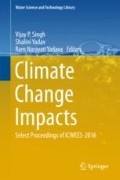Abstract
Study of changes in the global solar radiation is one of the key factors in sustainable agricultural production and management. Therefore, we investigated trends in the solar radiation using sunshine duration as a suitable alternative, based on the recommendation of the FAO Irrigation and Drainage—Paper No. 56, by using the Mann-Kendall (MK) test at different time scales in the humid environments of Northeast India. The average annual bright sunshine hours over Agartala is found to be 6.6 hours (h) with a standard deviation of 0.4 h and coefficient of variation of 6.4%. On annual (seasonal) time scale, statistically significant decreasing trends in bright sunshine duration through the MK test were observed at 5% level of significance at the rate of 0.245 h/decade (0.545 and 0.118 h/decade in winter and monsoon) over Agartala. Similarly, sunshine decreases were observed in the months of January, February, March, May, September, October, and December in the range of 0.237–0.688 h/decade. The observed decreases in sunshine duration modify the evapotranspiration process and affect the crop water requirements, which, in turn, will negatively influence the agricultural production in humid environments of Northeast India.
Access this chapter
Tax calculation will be finalised at checkout
Purchases are for personal use only
References
Allen RG, Pereira LS, Raes D, Smith M (1998) Crop evapotranspiration: guidelines for computing crop requirements. FAO Irrigation and Drainage Paper No. 56, FAO Rome, Italy
Dinpashoh Y, Jhajharia D, Fakheri-Fard A, Singh VP, Kahya E (2011) Trends in reference evapotranspiration over Iran. J Hydrol 399:422–433
Hess A, Iyer H, Malm W (2001) Linear trend analysis: a comparison of methods. Atmos Environ 35(30):5211–5222
Jhajharia D, Roy S, Ete G (2007) Climate and its variation: a case study of Agartala. J Soil Water Conserv 6(1):29–37
Jhajharia D, Shrivastava SK, Sarkar D, Sarkar S (2009) Temporal characteristics of pan evaporation trends under the humid conditions of northeast India. Agric For Meteorol 149:763–770
Jhajharia D, Dinpashoh Y, Kahya E, Singh VP, Fakheri-Fard A (2012) Trends in reference evapotranspiration in the humid region of northeast India. Hydrol Process. doi:10.1002/hyp.8140
Kendall MG (1975) Rank correlation methods, 4th edn. Charles Griffin, London
Mann HB (1945) Non-parametric tests against trend. Econometrica 33:245–259
Magnus JR, Melenberg B, Muris C (2011) Global warming and local dimming: the statistical evidence. J Am Stat Assoc 106:452–464
McVicar TR, Roderick ML, Donohue RJ, Li LT, Van Niel TG et al (2012) Global review and synthesis of trends in observed terrestrial near-surface wind speeds: implications for evaporation. J Hydrol 416–417:182–205
Pandey PK, Dabral PP, Pandey V (2016) Evaluation of reference evapotranspiration methods for the northeastern region of India. Int Soil Water Conserv Res 4:52–63. doi:10.1016/j.iswcr.2016.02.003
Pandey V, Pandey PK, Mahanta AP (2014) Calibration and performance verification of Hargreaves-Samani equation in a humid region. Irrig Drain 63:659–667. doi:10.1002/ird.1874
Stanhill G (1965) A comparison of four methods of estimating solar radiation. In: Eckardt FE (ed) Methodology of plant eco-physiology. In: Proceedings of the Montpellier symposium, Arid Zone Research, XXV. UNESCO, Paris, pp 55–61
Stanhill G, Cohen S (2001) Global dimming: a review of the evidence for a widespread and significant reduction in global radiation with discussion of its probable causes and possible agricultural consequences. Agric For Meteorol 107:255–278
WMO (1997) Measurement of radiation guide to meteorological instruments and methods of observation (Chap. 7), 6th edn. World Meteorological Organization, Geneva
Acknowledgements
The authors thank the India Meteorological Department (Pune) for providing the climatic data used in this study.
Author information
Authors and Affiliations
Corresponding author
Editor information
Editors and Affiliations
Rights and permissions
Copyright information
© 2018 Springer Nature Singapore Pte Ltd.
About this paper
Cite this paper
Jhajharia, D. et al. (2018). Changes in Sunshine Duration in Humid Environments of Agartala (Tripura), India. In: Singh, V., Yadav, S., Yadava, R. (eds) Climate Change Impacts. Water Science and Technology Library, vol 82. Springer, Singapore. https://doi.org/10.1007/978-981-10-5714-4_2
Download citation
DOI: https://doi.org/10.1007/978-981-10-5714-4_2
Published:
Publisher Name: Springer, Singapore
Print ISBN: 978-981-10-5713-7
Online ISBN: 978-981-10-5714-4
eBook Packages: Earth and Environmental ScienceEarth and Environmental Science (R0)

